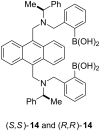Self and directed assembly: people and molecules
- PMID: 27340435
- PMCID: PMC4902004
- DOI: 10.3762/bjoc.12.42
Self and directed assembly: people and molecules
Abstract
Self-assembly and directed-assembly are two very important aspects of supramolecular chemistry. As a young postgraduate student working in Canada with Tom Fyles my introduction to Supramolecular Chemistry was through the self-assembly of phospholipid membranes to form vesicles for which we were developing unimolecular and self-assembling transporter molecules. The next stage of my development as a scientist was in Japan with Seiji Shinkai where in a "Eureka" moment, the boronic acid templating unit (directed-assembly) of Wulff was combined with photoinduced electron transfer systems pioneered by De Silva. The result was a turn-on fluorescence sensor for saccharides; this simple result has continued to fuel my research to the present day. Throughout my career as well as assembling molecules, I have enjoyed bringing together researchers in order to develop collaborative networks. This is where molecules meet people resulting in assemblies worth more than the individual "molecule" or "researcher". My role in developing networks with Japan was rewarded by the award of a Daiwa-Adrian Prize in 2013 and I was recently rewarded for developing networks with China with an Inaugural CASE Prize in 2015.
Keywords: boronic acids; fluorescence; glucose sensor; self and directed assembly; supramolecular.
Figures

















Similar articles
-
Responsive nanostructures from aqueous assembly of rigid-flexible block molecules.Acc Chem Res. 2011 Jan 18;44(1):72-82. doi: 10.1021/ar100111n. Epub 2010 Dec 3. Acc Chem Res. 2011. PMID: 21128602
-
Boronic acid-based chemical sensors for saccharides.Carbohydr Res. 2017 Nov 27;452:129-148. doi: 10.1016/j.carres.2017.10.010. Epub 2017 Oct 20. Carbohydr Res. 2017. PMID: 29096186
-
Coordination-Driven Syntheses of Compact Supramolecular Metallacycles toward Extended Metallo-organic Stacked Supramolecular Assemblies.Acc Chem Res. 2017 Apr 18;50(4):885-894. doi: 10.1021/acs.accounts.6b00624. Epub 2017 Mar 6. Acc Chem Res. 2017. PMID: 28263559
-
Art, auto-mechanics, and supramolecular chemistry. A merging of hobbies and career.Beilstein J Org Chem. 2016 Feb 26;12:362-76. doi: 10.3762/bjoc.12.40. eCollection 2016. Beilstein J Org Chem. 2016. PMID: 26977197 Free PMC article. Review.
-
Supramolecular Chemistry in Microflow Fields: Toward a New Material World of Precise Kinetic Control.Chem Asian J. 2015 Dec;10(12):2574-88. doi: 10.1002/asia.201500555. Epub 2015 Sep 15. Chem Asian J. 2015. PMID: 26288064 Review.
Cited by
-
Supramolecular assemblies in the molecular complexes of 4-cyanophenylboronic acid with different N-donor ligands.RSC Adv. 2023 Aug 2;13(33):23267-23284. doi: 10.1039/d3ra03936f. eCollection 2023 Jul 26. RSC Adv. 2023. PMID: 37538513 Free PMC article.
References
-
- [Oct 23;2015 ]; Available from: http://www.bbc.co.uk/iplayer/episode/p018dvyg/horizon-19811982-9-the-ple....
-
- Archer R D, Wood J S, Cook M J, Lamet M S. J Chem Educ. 1997;74:486. doi: 10.1021/ed074p486. - DOI
-
- Alexander R P, James T D, Stephenson G R. J Chem Soc, Dalton Trans. 1987:2013–2016. doi: 10.1039/dt9870002013. - DOI
-
- Carmichael V E, Dutton P J, Fyles T M, James T D, Swan J A, Zojaji M. J Am Chem Soc. 1989;111:767–769. doi: 10.1021/ja00184a075. - DOI
-
- Fyles T M, James T D, Kaye K C. Can J Chem. 1990;68:976–978. doi: 10.1139/v90-153. - DOI
Publication types
LinkOut - more resources
Full Text Sources
Other Literature Sources
Research Materials
